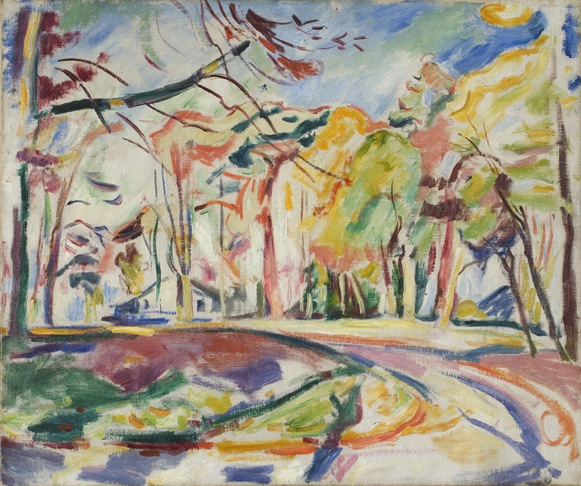The Davis Museum is closed for Wellesley College’s winter break. Please join us at our spring opening celebration on February 5, 2026, at 4 pm.
Landscape

In 1905, when The Salon d’Automne in Paris showed the colorful and expressive pieces by Henri Matisse, André Derain, and other painters, critics and audiences felt threatened by the crudeness of their works and called them “Fauves,” French for “The Wild Beasts,” a name that has stuck. But Othon Friesz, a classically trained young artist, was not frightened by this new way of painting and using colors: he was fascinated. And inspired.
Impressionists considered color as the organizing element of a painting. The Fauves went further. Pursuing Vincent Van Gogh’s aesthetic, they chose to put pure unmixed colors on canvas, highlighting the brushstroke and playing with complementary colors put side by side. They created shadows and texture through this process, for example the primary green put near a red pattern to express the shadow of the tree, on the left of this painting. Far from the meticulous work done by Claude Monet, Van Gogh, and even Matisse, Friesz reveals the narrative and the compositional elements– the perspective that leads us to the house in the back, behind trees shaken by the wind – through a large, expressive and dynamic brushstroke. This colorful linear brushstroke eventually becomes the key element of the compositional design. The thin dark branches of the tree in the foreground remind us of Japanese drawings, very trendy in Europe at that time, and the elegant lines and contours of the figures in Matisse’s 1906 Joy of Life painting.
In Friesz’s Landscape, there is no will to paint reality as it is, neither as we perceive it, nor as we idealize it. This is not about representation, but about expression, shocking the audience’s eyes. Almost absent of narration, Landscape is a painting which speaks about art itself, and no longer of nature. Like a manifesto for the Fauves’ technique and theory, painted by an enthusiastic disciple, this formal work leads us into the land of abstraction.
Si certains critiques et spectateurs se sentirent agressés, lors du Salon d’Automne de 1905, face aux toiles d’Henri Matisse, André Derain et ceux qu’on appellera alors à la suite de Louis Vauxcelles les « Fauves », ce ne fut pas le cas d’Othon Friesz. Artiste de formation et de style plutôt classiques, il est immédiatement fasciné par cette nouvelle manière de peindre et d’utiliser la couleur.
Après les Impressionnistes qui ont fait du coloris l’élément structurant du tableau, les Fauves appliquent la couleur sur la toile sans la mélanger ni la nuancer, insistant sur la touche et le jeu des juxtapositions, dans la poursuite de la réflexion de Vincent Van Gogh. Ils créent l’ombre et le relief par des chocs visuels colorés, comme ici ce vert près d’une zone rouge qui révèle l’ombre de l’arbre sur la gauche du tableau. Loin du travail minutieux de Monet, de Van Gogh, ou même de Matisse, Friesz laisse transparaître la narration – la perspective qui nous conduit jusqu’à la maison, derrière les arbres battus par le vent – par une grande touche, dynamique et expressive. Cette touche de couleur pure devient même structurante, linéaire, dessinant la composition. Les branches sombres et fines de l’arbre au premier plan rappellent l’utilisation du cerne élégant et gracile de Matisse dans Le Bonheur de Vivre (1906), en même temps qu’elles révèlent l’influence des estampes japonaises, en vogue en Europe à cette période.
Ici, pas de volonté de peindre le réel tel qu’il est, tel qu’on le perçoit, ou tel qu’on l’idéalise. Il ne s’agit plus de représenter, mais d’exprimer, par le choc visuel. Avec une narration réduite à son minimum, Paysage est un tableau qui parle de peinture, non plus de nature. Manifeste de la technique des fauves réalisé par un élève conquis, actualisation d’une théorie sur la peinture, cette œuvre formelle nous emmène déjà, presque malgré elle, sur les terres de l’abstraction.
Emma Fonteneau
2012 Liliane Pingoud Soriano Curatorial Fellow